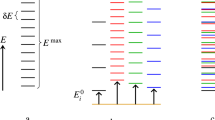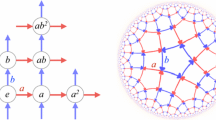Abstract
We wrap up the main outcomes of our investigations. Even if not all questions and issues could be addressed as precisely and persuasively as one would wish, we do find that the assumption of an underlying theory describing a single, definite world with completely deterministic evolution laws, can be maintained and pursued further. In the more distant future, it is hoped that the Cellular Automaton Theory will enable us to select credible models for grand unification an quantized gravity; in the mean while, the Cellular Automaton Interpretation will be helpful in visualizing what we are actually doing when we are involved with quantum mechanical calculations.
You have full access to this open access chapter, Download chapter PDF
Similar content being viewed by others
Keywords
These keywords were added by machine and not by the authors. This process is experimental and the keywords may be updated as the learning algorithm improves.
We had three reasons for working out many of our technical exercises in the second part of this book. First, we wanted to show what techniques can be used to support our assertions made earlier, which state that there are many ways to link quantum mechanical models with completely deterministic ones. Most of these deterministic models were chosen just to demonstrate some points; these were too simple to show delicate structures of direct physical interest. Some of our models are “computationally universal”, which means that they contain sufficient amounts of complexity to investigate their physical interest [37, 61].
Secondly, we wish to demonstrate that conventional quantum mechanics contains extensive mathematical tools that can be employed here as well. Fourier expansions, Taylor expansions, unitary transformations in Hilbert space, perturbation expansions, the Noether theorem, and other well-known procedures, are all extremely useful here. We wish to sketch the picture that quantum mechanics, as we know it, should be looked upon as a powerful mathematical tool to handle statistical features of our theories. If the dynamical equations are too complex to allow us to solve them, the quantum statistical approach may be the only option we have. No other systematic mathematical machinery would allow us to examine statistical features of any non-trivial cellular automaton when stretched over scales a billion times a billion times as large as the elementary scale of the individual cells. In quantized field theories, the tool that makes such jumps over scales is called the renormalization group.
Thirdly, we do not want to belittle the difficulties that are still there. A completely systematic strategy for constructing models as complex as the Standard Model, has not yet been found; instead, we found several procedures that could be considered as useful ingredients for such a strategy, even if still quite incomplete. We emphasise that “no-go” theorems, such as Bell’s theorem and the CHSH inequalities, do contain the loopholes that have been pointed out repeatedly. “Super determinism”, abhorred by a majority of researchers, becomes less fearsome if one realizes that it comes with its own conservation law, the conservation of the ontic nature of a quantum state. To describe our universe, we have to limit ourselves to the ontic states. These form a very small subset of the “template states” that are normally used in quantum mechanics. Ontic states can only evolve into ontic states.
The issue of ‘conspiracy’ may still be worrisome to the reader, even if it is clear that our theory will not allow us to predict anything about the settings to be used by Alice and Bob. The notion of ‘free will’ can be addressed without religious or emotional overtones; it is simply a statement about correlation functions in the initial state, see Sect. 3.8 about this. Complete clarifications of some issues may have to wait until more is known about how to handle quantum field theories such as the Standard Model, and quantum gravity, in the CAI.
Quite generally, symmetries, symmetry conservation laws and symmetry transformations, are central not only in conventional quantum mechanics but also in its CA interpretation. A special point was raised in connection with the non-compact, or infinite symmetry groups, such as the various components of the Poincaré group. Their Noether charges are observable in the classical limit, but in the quantum domain these charges do not commute. This means that these charges must be conglomerates of beables and changeables, and this causes complications in reproducing such symmetries as features in our cellular automata.
We found a conspicuous property of the quantized strings and superstrings. Without modifying any of their physics, it was noted that their ontological degrees of freedom appear to live on a space–time lattice, with a lattice length parameter \(a_{\mathrm{spacetime}}=2\pi \sqrt{\alpha '}\). This not only reflects the fact that string theory is finite, but gives it a clear physical interpretation.
The Cellular Automaton Interpretation has to deal with more mysteries. We do reproduce quantum mechanics exactly, so also the numerous peculiarities and counter intuitive characteristics of quantum mechanics are duly reproduced. There are however other reasons why the most explicit model constructions sketched here are not, or not yet, sufficiently refined to serve as models where we can explain all typically quantum mechanical consequences. A critical reader may rightly point to these obstacles; we bring forward as our defence that the Cellular Automaton Interpretation of quantum mechanics yields a considerable amount of clarification of features of quantum mechanics that have been shrouded by mysteries over the years: the collapse question, the measurement problem, Schrödinger’s cat, the links between quantum mechanical descriptions and classical descriptions of our world, as well as clear indications as to how to avoid the “many worlds” as well as the “pilot waves”. All these came as bonuses, while our real motivation has always been the question of reconciling the gravitational force with quantum mechanics. We suspect that the work presented here will be very helpful in achieving such aims.
Not only the interpretation of quantum mechanics, but also some issues in the foundations of quantum field theories may be at stake in this approach. We observed that the procedure of second quantization may have to be applied not only in the use of quantum field theories, but also for the construction of our Hamiltonian, and this raises issues of convergence of the perturbation expansion. Our conclusion is now that this expansion may not converge, just as what we have in quantum field theory. Here, however, this leads us to suggest a novel implication: there is an unavoidable margin of error not only in our use of quantum field theories to calculate particle properties, but a similar margin of error may also exist in our use of quantum mechanics altogether: quantum calculations cannot be done with infinite accuracy.
Perhaps the only infinitely precise calculations that can be done are explicit computer simulations of the cellular automata themselves.
References
E. Fredkin, T. Toffoli, Int. J. Theor. Phys. 21, 219 (1982)
D.B. Miller, E. Fredkin, Two-state, reversible, universal cellular automata in three dimensions, in Proc. 2nd Conf. on Computing Frontiers, ACM 45, Ischia, Italy (2005). arXiv:nlin/0501022. doi:10.1145/1062271
Author information
Authors and Affiliations
Rights and permissions
This chapter is distributed under the terms of the Creative Commons Attribution 4.0 International License (http://creativecommons.org/licenses/by/4.0/), which permits use, duplication, adaptation, distribution and reproduction in any medium or format, as long as you give appropriate credit to the original author(s) and the source, a link is provided to the Creative Commons license and any changes made are indicated.
The images or other third party material in this chapter are included in the work's Creative Commons license, unless indicated otherwise in the credit line; if such material is not included in the work's Creative Commons license and the respective action is not permitted by statutory regulation, users will need to obtain permission from the license holder to duplicate, adapt or reproduce the material.
Copyright information
© 2016 The Author(s)
About this chapter
Cite this chapter
’t Hooft, G. (2016). Conclusions of Part II. In: The Cellular Automaton Interpretation of Quantum Mechanics. Fundamental Theories of Physics, vol 185. Springer, Cham. https://doi.org/10.1007/978-3-319-41285-6_23
Download citation
DOI: https://doi.org/10.1007/978-3-319-41285-6_23
Published:
Publisher Name: Springer, Cham
Print ISBN: 978-3-319-41284-9
Online ISBN: 978-3-319-41285-6
eBook Packages: Physics and AstronomyPhysics and Astronomy (R0)




